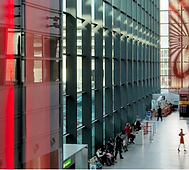A Smooth Guide ...
SUNBURY and SUNBURY ON THAMES
People, places and things of interest in Sunbury, Shepperton, Ashford, Hampton, Hampton Court, Staines upon Thames
AIRPORTS




Heathrow Airport is a major international airport in west London, England, UK. Heathrow is the busiest airport in the United Kingdom, busiest airport in Europe by passenger traffic, and sixth busiest airport in the world by total passenger traffic. In 2014, it handled a record 73.4 million passengers, a 1.4 percent increase from 2013.
Heathrow Airport started in 1929 as a small airfield (Great West Aerodrome) on land south-east of the hamlet of Heathrow from which the airport takes its name. At that time there were farms, market gardens and orchards there: there was a "Heathrow Farm" about where Terminal 1 is now, a "Heathrow Hall" and a "Heathrow House". This hamlet was largely along a country lane (Heathrow Road) which ran roughly along the east and south edges of the present central terminals area.
Development of the whole Heathrow area as a very big airfield started in 1944: it was stated to be for long-distance military aircraft bound for the Far East. But by the time the airfield was nearing completion, World War II had ended. The Government continued to develop the airfield as a civil airport; opened as London Airport in 1946 and renamed Heathrow Airport in 1966.
The masterplan for the airport was designed by Sir Frederick Gibberd, who designed the original terminals and central area buildings, including the original control tower and multi-faith chapel of St George's.
Heathrow Terminal 1 was one of five airport Terminals at Heathrow Airport, serving the capital city of London.
Terminal 1 closed on 29 June 2015. Prior to its closure, it was only occupied by British Airways which operated just 20 daily flights to 9 destinations. Its demolition enabled construction of the second phase of Terminal 2.


-
Flight information
-
Driving directions
-
Public transport
-
Airlines and information about services and facilities
-
Shops and Restaurants
-
Getting around the Airport
-
Travelling between Terminals
If you're not sure which terminal you need, please visit the Which Terminal? page.

-
Flight information
-
Driving directions
-
Public transport
-
Airlines and information about services and facilities
-
Shops and Restaurants
-
Getting around the Airport
-
Travelling between Terminals
If you're not sure which terminal you need, please visit our Which Terminal? page.

-
Flight information
-
Driving directions
-
Public transport
-
Airlines and information about services and facilities
-
Shops and Restaurants
-
Getting around the Airport
-
Travelling between Terminals
If you're not sure which terminal you need, please visit our Which Terminal? page.

-
Flight information
-
Driving directions
-
Public transport
-
Airlines and information about services and facilities
-
Shops and Restaurants
-
Getting around the Airport
-
Travelling between Terminals
If you're not sure which terminal you need, please visit our Which Terminal? page.
Gatwick Airport is 2.7 nautical miles (5.0 km; 3.1 miles) north of the centre of Crawley,West Sussex, and 29.5 miles (47.5 km) south of Central London.
Also known as London Gatwick, it is London's second-largest international airport and the second-busiest (by total passenger traffic) in the United Kingdom (after Heathrow).
Gatwick is Europe's leading airport for point-to-point flights and has the world's busiest single-use runway, with a maximum of 55 aircraft movements per hour. Its two terminals (North and South) cover an area of 1,050,000 sq ft and 1,700,000 sq ft respectively.
In 2015, 40.3 million passengers passed through the airport, a 5.6 percent increase compared with 2014.
-
At the Airport
-
Live Flights
-
To and From the Airport
-
Parking
-
Hotels
-
Shops and Restaurants
-
Flight Connections
-
Passenger Services
-
Contact Details